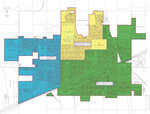Clear, 52° F
Population data suggests residents in the southern and eastern portions of Powell have been underrepresented on the city council in recent years, but that will change with the upcoming election.
…
This item is available in full to subscribers.
The Powell Tribune has expanded its online content. To continue reading, you will need to either log in to your subscriber account, or purchase a subscription.
If you are a current print subscriber, you can set up a free web account by clicking here.
If you already have a web account, but need to reset it, you can do so by clicking here.
If you would like to purchase a subscription click here.
Please log in to continue |
|


Population data suggests residents in the southern and eastern portions of Powell have been underrepresented on the city council in recent years, but that will change with the upcoming election.
To ensure that council members come from different areas, the city is split into three wards that should theoretically hold about the same number of people; with the 2020 Census putting the Powell’s population at 6,149 residents, each ward would ideally have about 2,140 people.
However, staff at the Park County Elections Department noticed a couple wards had gotten out of whack.
According to the Census data, council members in Ward 1 were representing only 1,803 people, while councilors in Ward 3 had 2,570 constituents.
“There’s a big deviation,” First Deputy Park County Clerk Hans Odde told councilors at their Feb. 5 meeting.
Courts have held that voter districts should generally be within 5% of the ideal population, which would mean having between 2,033 and 2,247 people in each of Powell’s wards.
To even out the city’s numbers, Odde and Elections Deputy Katie Johnson recommended taking a portion of Ward 3 and moving it into Ward 1 — and the council unanimously adopted the plan last week. None of the current Ward 1 or Ward 3 council members live in the affected area, so the change won’t impact their ability to run for office.
“Seems like everything about it makes sense,” said Ward 1 Councilman Steve Lensegrav.
Based on the 2020 Census data, the newly expanded Ward 1 holds 2,178 residents. The ward, which includes the Northwest College campus, has grown to include everyone living north of Fourth Street. It’s also spread a few blocks to the east — now stretching as far as the former Fitch Building — and slightly south in some areas. Its western boundary remains Division Street.
As for Ward 3, it continues to include the entire south side of town, plus portions of the north side between Division and Jones streets. The ward generally stops at Third Street, with just a few blocks reaching to Fourth. Based on the 2020 Census data, it contains 2,195 people.
Ward 1 is represented by Lensegrav and Geoff Hovivian while Ward 3 is represented by Tim Sapp and Lesli Spencer; Hovivian and Spencer’s seats are up for election this year.
Ward 2 — which was already close to the “ideal” population at 2,058 — remains unchanged; it continues to include everyone living west of Division Street. The ward is represented by Floyd Young — whose term ends this year — and Zane Logan.
Although it has the lowest population, Ward 2 consistently has the highest voter turnout among the three districts.
In another change, elections staffers are also hoping to eliminate two duplicative voter precincts in the city by combining precinct 9-1 with 9-2 and precinct 9-4 with 9-5. Although they have separate ballots, those pairs of precincts share the same candidates and races in the general election (9-1 and 9-2 make up Ward 1, while 9-4 and 9-5 make Ward 2).
“You live across the street from your neighbor, and they get a 9-4 ballot and you get a 9-5 ballot that are exactly the same,” Odde explained, telling the council that “there’s no real reason” to keep those precincts separate.
Consolidating would mean two fewer ballot types for election judges to deal with, Odde said, which “decreases the chances that somebody may get an incorrect ballot or something.”
Although the change wouldn’t affect the general election ballot, it would have an impact on primary ballots and on the county’s major political parties. Based on preliminary calculations by elections staff, the consolidation would eliminate four precinct committee positions within the Park County Democratic Party and two others within the Park County Republican Party.
While council members didn’t raise any concerns about the plan, the decision on whether to consolidate precincts will ultimately rest with the Park County commissioners.
Powell is not the only local government to readjust its boundaries this year, as elections staff have been working with other councils and boards to rebalance voting districts across the county.